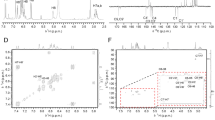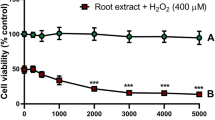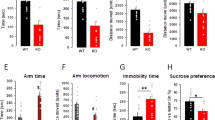Abstract
Extracts of the plant St John's wort, Hyperforin perforatum L., have been used for centuries in traditional medicine, notably for the treatment of depression. One of their main lipophilic components, a natural prenylated phloroglucinol termed hyperforin (HF), has been identified as the major molecule responsible for the antidepressant effects of this plant. Within the last few years, a number of studies have demonstrated that HF displays, in addition, several other biological properties of potential pharmacological interest. They include an antibacterial capacity and inhibitory effects on inflammatory mediators. It is worth noting that HF also promotes apoptosis of various cancer cells from solid tumors and hematological malignancies, including B-cell chronic lymphocytic leukemia. In addition, HF inhibits the capacity of migration and invasion of different tumor cells, as well as exhibiting antiangiogenic effects. Altogether, these properties qualify HF as a lead structure for the development of new therapeutic molecules in the treatment of various diseases, including some malignant tumors.
This is a preview of subscription content, access via your institution
Access options
Subscribe to this journal
Receive 12 print issues and online access
$259.00 per year
only $21.58 per issue
Buy this article
- Purchase on Springer Link
- Instant access to full article PDF
Prices may be subject to local taxes which are calculated during checkout

Similar content being viewed by others
References
Quiney C, Billard C, Faussat AM, Salanoubat C, Ensaf A, Nait-Si Y et al. Pro-apoptotic properties of hyperforin in leukemic cells from patients with B-cell chronic lymphocytic leukemia. Leukemia 2006; 20: 491–497.
Quiney C, Billard C, Mirshahi P, Fourneron JD, Kolb JP . Hyperforin inhibits MMP-9 secretion by B-CLL cells and microtubule formation by endothelial cells. Leukemia 2006; 20: 583–589.
Di Carlo G, Borrelli F, Ernst E, Izzo AA . St John's wort: prozac from the plant kingdom. Trends Pharmacol Sci 2001; 22: 292–297.
Mennini T, Gobbi M . The antidepressant mechanism of Hypericum perforatum. Life Sci 2004; 75: 1021–1027.
Gaind KN, Ganjoo TN . Antibacterial principle of Hypericum perforatum L. Indian J Pharm 1959; 21: 172–175.
Gurevich AI, Dobrynin VN, Kolosov MN, Popravko SA, Riabova ID . Antibiotic hyperforin from Hypericum perforatum L. Antibiotiki 1971; 16: 510–513.
Bystrov NS, Chernov BK, Dobrynin VN, Kolosov MN . The structure of hyperforin. Tetrahedron Lett 1975; 32: 2791–2794.
Adam P, Arigoni D, Bacher A, Eisenreich W . Biosynthesis of hyperforin in Hypericum perforatum. J Med Chem 2002; 45: 4786–4793.
Barnes J, Anderson LA, Phillipson JD . St John's wort (Hypericum perforatum L.): a review of its chemistry, pharmacology and clinical properties. J Pharm Pharmacol 2001; 53: 583–600.
Chandrasekera DH, Welham KJ, Ashton D, Middleton R, Heinrich M . Quantitative analysis of the major constituents of St John's wort with HPLC-ESI-MS. J Pharm Pharmacol 2005; 57: 1645–1652.
Agostinis P, Vantieghem A, Merlevede W, deWitte PA . Hypericin in cancer treatment: more light on the way. Int J Biochem Cell Biol 2002; 34: 221–241.
Tedeschi E, Menegazzi M, Margotto D, Suzuki H, Forstermann U, Kleinert U . Anti-inflammatory actions of St. John's wort: inhibition of human inducible nitric-oxide synthase expression by down-regulating signal transducer and activator of transcription-1alpha (STAT-1alpha) activation. J Pharmacol Exp Ther 2003; 307: 254–261.
Cervo L, Rozio M, Ekalle-Soppo CB, Guiso G, Morazzoni P, Caccia S . Role of hyperforin in the antidepressant-like activity of Hypericum perforatum extracts. Psychopharmacology (Berlin) 2002; 164: 423–428.
Medina MA, Martinez-Poveda B, Amores-Sanchez MI, Quesada AR . Hyperforin: More than an antidepressant bioactive compound? Life Sci 2006; 79: 105–111.
Gobbi M, Mennini T . Is St John's wort a ‘Prozac- like’ herbal antidepressant? Trends Pharmacol Sci 2001; 22: 557–559.
Nathan PJ . Hypericum perforatum (St John's Wort): a non-selective reuptake inhibitor? A review of the recent advances in its pharmacology. J Psychopharmacol 2001; 15: 47–54.
Schulte-Lobbert S, Holoubek G, Muller WE, Schubert-Zsilavecz M, Wurglics M . Comparison of the synaptosomal uptake inhibition of serotonin by St John's wort products. J Pharm Pharmacol 2004; 56: 813–818.
Butterweck V, Nahrstedt A, Evans J, Hufeisen S, Rauser L, Savage J et al. In vitro receptor screening of pure constituents of St John's wort reveals novel interactions with a number of GPCRs. Psychopharmacology (Berlin) 2002; 162: 193–202.
Muller WE, Singer A, Wonnemann M, Hafner U, Rolli M, Schafer C . Hyperforin represents the neurotransmitter reuptake inhibiting constituent of hypericum extract. Pharmacopsychiatry 1998; 31 (Suppl 1): 16–21.
Singer A, Wonnemann M, Muller WE . Hyperforin, a major antidepressant constituent of St John's Wort, inhibits serotonin uptake by elevating free intracellular Na+. J Pharmacol Exp Ther 1999; 290: 1363–1368.
Chatterjee SS, Biber A, Weibezahn C . Stimulation of glutamate, aspartate and gamma-aminobutyric acid release from synaptosomes by hyperforin. Pharmacopsychiatry 2001; 34 (Suppl 1): S11–S19.
Verotta L, Appendino G, Belloro E, Bianchi F, Sterner O, Lovati M et al. Synthesis and biological evaluation of hyperforin analogues. Part I. Modification of the enolized cyclohexanedione moiety. J Nat Prod 2002; 65: 433–438.
Wonnemann M, Singer A, Muller WE . Inhibition of synaptosomal uptake of 3H-L-glutamate and 3H-GABA by hyperforin, a major constituent of St John's Wort: the role of amiloride sensitive sodium conductive pathways. Neuropsychopharmacology 2000; 23: 188–197.
Roz N, Mazur Y, Hirshfeld A, Rehavi M . Inhibition of vesicular uptake of monoamines by hyperforin. Life Sci 2002; 71: 2227–2237.
Roz N, Rehavi M . Hyperforin depletes synaptic vesicles content and induces compartmental redistribution of nerve ending monoamines. Life Sci 2004; 75: 2841–2850.
Marsh WL, Davies JA . The involvement of sodium and calcium ions in the release of amino acid neurotransmitters from mouse cortical slices elicited by hyperforin. Life Sci 2002; 71: 2645–2655.
Treiber K, Singer A, Henke B, Muller WE . Hyperforin activates nonselective cation channels (NSCCs). Br J Pharmacol 2005; 145: 75–83.
Eckert GP, Keller JH, Jourdan C, Karas M, Volmer DA, Schubert-Zsilavecz M et al. Hyperforin modifies neuronal membrane properties in vivo. Neurosci Lett 2004; 367: 139–143.
Koch E, Chatterjee SS . Hyperforin stimulates intracellular calcium mobilisation and enhances extracellular acidification in DDT1-MF2 smooth muscle cells. Pharmacopsychiatry 2001; 34 (Suppl 1): S70–S73.
Klusa V, Germane S, Noldner M, Chatterjee SS . Hypericum extract and hyperforin: memory-enhancing properties in rodents. Pharmacopsychiatry 2001; 34 (Suppl 1): S61–S69.
Kiewert C, Buchholzer ML, Hartmann J, Chatterjee SS, Klein J . Stimulation of hippocampal acetylcholine release by hyperforin, a constituent of St John's Wort. Neurosci Lett 2004; 364: 195–198.
Froestl B, Steiner B, Muller WE . Enhancement of proteolytic processing of the beta-amyloid precursor protein by hyperforin. Biochem Pharmacol 2003; 66: 2177–2184.
Maisenbacher P, Kovar KA . Analysis and stability of Hyperici oleum. Planta Med 1992; 58: 351–354.
Schempp CM, Winghofer B, Ludtke R, Simon-Haarhaus B, Schopf E, Simon JC . Topical application of St John's wort (Hypericum perforatum L.) and of its metabolite hyperforin inhibits the allostimulatory capacity of epidermal cells. Br J Dermatol 2000; 142: 979–984.
Schempp CM, Hezel S, Simon C . Topical treatment of atopic dermatitis with Hypericum cream: a randomised, placebo-controlled, double-blind half-side comparison study. Hautarzt 2003; 54: 248–253.
Heilmann J, Winkelmann K, Sticher O . Studies on the antioxidative activity of phloroglucinol derivatives isolated from hypericum species. Planta Med 2003; 69: 202–206.
Albert D, Zundorf I, Dingermann T, Muller WE, Steinhilber D, Werz O . Hyperforin is a dual inhibitor of cyclooxygenase-1 and 5-lipoxygenase. Biochem Pharmacol 2002; 64: 1767–1775.
Feisst C, Werz O . Suppression of receptor-mediated Ca2+ mobilization and functional leukocyte responses by hyperforin. Biochem Pharmacol 2004; 67: 1531–1539.
Zhou C, Tabb MM, Sadatrafiei A, Grun F, Sun A, Blumberg B . Hyperforin, the active component of St John's wort, induces IL-8 expression in human intestinal epithelial cells via a MAPK-dependent, NF-kappaB-independent pathway. J Clin Immunol 2004; 24: 623–636.
Schempp CM, Pelz K, Wittmer A, Schopf E, Simon JC . Antibacterial activity of hyperforin from St John's wort, against multiresistant Staphylococcus aureus and Gram-positive bacteria. Lancet 1999; 353: 2129.
Reichling J, Weseler A, Saller R . A current review of the antimicrobial activity of Hypericum perforatum L. Pharmacopsychiatry 2001; 34 (Suppl 1): S116–S118.
Avato P, Raffo F, Guglielmi G, Vitali C, Rosato A . Extracts from St John's wort and their antimicrobial activity. Phytother Res 2004; 18: 230–232.
Mannel M . Drug interactions with St John's wort: mechanisms and clinical implications. Drug Saf 2004; 27: 773–797.
Obach RS . Inhibition of human cytochrome P450 enzymes by constituents of St. John's Wort, an herbal preparation used in the treatment of depression. J Pharmacol Exp Ther 2000; 294: 88–89.
Mai I, Bauer S, Perloff ES, Johne A, Uehleke B, Frank B et al. Hyperforin content determines the magnitude of the St John's wort–cyclosporine drug interaction. Clin Pharmacol Ther 2004; 76: 330–340.
Komoroski BJ, Parise RA, Egorin MJ, Strom SC, Venkataramanan R . Effect of the St John's wort constituent hyperforin on docetaxel metabolism by human hepatocyte cultures. Clin Cancer Res 2005; 11: 6972–6979.
Mueller SC, Majcher-Peszynska J, Uehleke B, Klammt S, Mundkowski RG, Miekisch W et al. The extent of induction of CYP3A by St John's wort varies among products and is linked to hyperforin dose. Eur J Clin Pharmacol 2005; 10: 1–8.
Komoroski BJ, Zhang S, Cai H, Hutzler JM, Frye R, Tracy TS et al. Induction and inhibition of cytochromes P450 by the St John's wort constituent hyperforin in human hepatocyte cultures. Drug Metab Dispos 2004; 32: 512–518.
Wentworth JM, Agostini M, Love J, Schwabe JW, Chatterjee VK . St John's wort, a herbal antidepressant, activates the steroid X receptor. J Endocrinol 2000; 166: R11–R16.
Moore LB, Goodwin B, Jones SA, Wisely GB, Serabjit-Singh CJ, Willson TM et al. St. John's wort induces hepatic drug metabolism through activation of the pregnane X receptor. Proc Natl Acad Sci USA 2000; 97: 7500–7502.
Goodwin B, Moore LB, Stoltz CM, McKee DD, Kliewer SA . Regulation of the human CYP2B6 gene by the nuclear pregnane X receptor. Mol Pharmacol 2001; 60: 427–431.
Chen Y, Ferguson SS, Negishi M, Goldstein JA . Induction of human CYP2C9 by rifampicin, hyperforin, and phenobarbital is mediated by the pregnane X receptor. J Pharmacol Exp Ther 2004; 308: 495–501.
Pascussi JM, Robert A, Nguyen M, Walrant-Debray O, Garabedian M, Martin P et al. Possible involvement of pregnane X receptor-enhanced CYP24 expression in drug-induced osteomalacia. J Clin Invest 2005; 115: 177–186.
Gobbi M, Moia M, Funicello M, Riva A, Morazzoni P, Mennini T . In vitro effects of the dicyclohexylammonium salt of hyperforin on interleukin-6 release in different experimental models. Planta Med 2004; 70: 680–682.
Zhou S, Lim LY, Chowbay B . Herbal modulation of P-glycoprotein. Drug Metab Rev 2004; 36: 57–104.
Wang EJ, Barecki-Roach M, Johnson WW . Quantitative characterization of direct P-glycoprotein inhibition by St John's wort constituents hypericin and hyperforin. J Pharm Pharmacol 2004; 56: 123–128.
Weber CC, Kressmann S, Fricker G, Muller WE . Modulation of P-glycoprotein function by St John's wort extract and its major constituents. Pharmacopsychiatry 2004; 37: 292–298.
Patel J, Buddha B, Dey S, Pal D, Mitra AK . In vitro interaction of the HIV protease inhibitor ritonavir with herbal constituents: changes in P-gp and CYP3A4 activity. Am J Ther 2004; 11: 262–277.
Tian R, Koyabu N, Morimoto S, Shoyama Y, Ohtani H, Sawada Y . Functional induction and de-induction of P-glycoprotein by St. John's wort and its ingredients in a human colon adenocarcinoma cell line. Drug Metab Dispos 2005; 33: 547–554.
Hostanska K, Bommer S, Weber M, Krasniqi B, Saller R . Comparison of the growth-inhibitory effect of Hypericum perforatum L. extracts, differing in the concentration of phloroglucinols and flavonoids, on leukaemia cells. J Pharm Pharmacol 2003; 55: 973–980.
Hostanska K, Reichling J, Bommer S, Weber M, Saller R . Hyperforin a constituent of St John's wort (Hypericum perforatum L.) extract induces apoptosis by triggering activation of caspases and with hypericin synergistically exerts cytotoxicity towards human malignant cell lines. Eur J Pharm Biopharm 2003; 56: 121–132.
Dona M, Dell'Aica I, Pezzato E, Sartor L, Calabrese F, Della Barbera M et al. Hyperforin inhibits cancer invasion and metastasis. Cancer Res 2004; 64: 6225–6232.
Schempp CM, Kirkin V, Simon-Haarhaus B, Kersten A, Kiss J, Termeer CC et al. Inhibition of tumour cell growth by hyperforin, a novel anticancer drug from St John's wort that acts by induction of apoptosis. Oncogene 2002; 21: 1242–1250.
Skalkos D, Stavropoulos NE, Tsimaris I, Gioti E, Stalikas CD, Nseyo UO et al. The lipophilic extract of hypericum perforatum exerts significant cytotoxic activity against T24 and NBT-IIurinary bladder tumor cells. Planta Med 2005; 71: 1030–1035.
Zhao H, Dugas N, Mathiot C, Dugas B, Sigaux F, Kolb JP . B-cell chronic lymphocytic leukemia cells express a functional inducible nitric oxide synthase displaying anti-apoptotic activity. Blood 1998; 92: 1031–1043.
Dimmeler S, Haendeler J, Nehls M, Zeiher AM . Suppression of apoptosis by nitric oxide via inhibition of interleukin-1beta converting enzymes (ICE)-like and cysteine protease protein (CPP)-32-like proteases. J Exp Med 1997; 185: 601–607.
Vrhorac R, Delmer A, Tang R, Marie JP, Zittoun R, Ajchenbaum-Cymbalista F . Prognostic significance of the cell cycle inhibitor p27Kip1 in chronic lymphocytic leukemia. Blood 1998; 91: 4694–4700.
Martinez-Poveda B, Quesada AR, Medina MA . Hyperforin, a bio-active compound of St John's Wort, is a new inhibitor of angiogenesis targeting several key steps of the process. Int J Cancer 2005; 117: 775–780.
Schempp CM, Kiss J, Kirkin V, Averbeck M, Simon-Haarhaus B, Kremer B et al. Hyperforin acts as an angiogenesis inhibitor in vitro and in vivo. Planta Med 2005; 71: 999–1004.
Schwarz D, Kisselev P, Roots I . St. John's wort extracts and some of their constituents potently inhibit ultimate carcinogen formation from benzo[a]pyrene-7,8-dihydrodiol by human CYP1A1. Cancer Res 2003; 63: 8062–8068.
Biber A, Fischer H, Romer A, Chatterjee SS . Oral bioavailability of hyperforin from hypericum extracts in rats and human volunteers. Pharmacopsychiatry 1998; 31 (Suppl 1): 36–43.
Schulz HU, Schurer M, Bassler D, Weiser D . Investigation of pharmacokinetic data of hypericin, pseudohypericin, hyperforin and the flavonoids quercetin and isorhamnetin revealed from single and multiple oral dose studies with a hypericum extract containing tablet in healthy male volunteers. Arzneimittelforschung 2005; 55: 561–568.
Cui Y, Ang CY, Beger RD, Heinze TM, Hu L, Leakey J . In vitro metabolism of hyperforin in rat liver microsomal systems. Drug Metab Dispos 2004; 32: 28–34.
Muller WE . Current St John's wort research from mode of action to clinical efficacy. Pharmacol Res 2003; 47: 101–109.
Zanoli P, Rivasi M, Baraldi C, Baraldi M . Pharmacological activity of hyperforin acetate in rats. Behav Pharmacol 2002; 13: 645–651.
Gartner M, Muller T, Simon JC, Giannis A, Sleeman JP . Aristoforin, a novel stable derivative of hyperforin, is a potent anticancer agent. Chembiochem 2005; 6: 171–177.
Krusekopf S, Roots I . St. John's wort and its constituent hyperforin concordantly regulate expression of genes encoding enzymes involved in basic cellular pathways. Pharmacogenet Genom 2005; 15: 817–829.
Acknowledgements
C Quiney was a recipient of a fellowship from the Société Française d'Hématologie. This work was supported by Canceropôle Ile-de-France.
Author information
Authors and Affiliations
Corresponding author
Rights and permissions
About this article
Cite this article
Quiney, C., Billard, C., Salanoubat, C. et al. Hyperforin, a new lead compound against the progression of cancer and leukemia?. Leukemia 20, 1519–1525 (2006). https://doi.org/10.1038/sj.leu.2404301
Received:
Revised:
Accepted:
Published:
Issue Date:
DOI: https://doi.org/10.1038/sj.leu.2404301
Keywords
This article is cited by
-
The acylphloroglucinols hyperforin and myrtucommulone A cause mitochondrial dysfunctions in leukemic cells by direct interference with mitochondria
Apoptosis (2015)
-
Hyperforin Attenuates Brain Damage Induced by Transient Middle Cerebral Artery Occlusion (MCAO) in Rats via Inhibition of TRPC6 Channels Degradation
Journal of Cerebral Blood Flow & Metabolism (2013)
-
Determination of phenolic compounds in flowers of Hypericum species native to South Brazil and Peruvian Páramos
Plant Systematics and Evolution (2013)
-
Hyperforin is a modulator of inducible nitric oxide synthase and phagocytosis in microglia and macrophages
Naunyn-Schmiedeberg's Archives of Pharmacology (2010)
-
Noxa upregulation is associated with apoptosis of chronic lymphocytic leukemia cells induced by hyperforin but not flavopiridol
Leukemia (2009)



